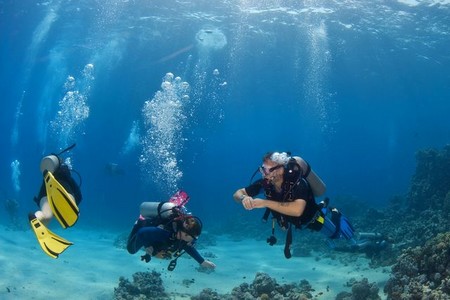When you are diving, one accident or mistake can lead to another. This is sometimes known as the incident pit. If a small thing goes wrong and is not corrected, before long a full-scale incident has developed. Always deal with any problems promptly.
Helping yourself
It is your responsibility to rescue yourself. For example, you should not continue a dive when you know you are running low on air because you know your buddy has plenty. You must finish the dive so that you do not have to resort to sharing the air of another diver.
If you forget your computer, abort the dive – you should not try to manage the dive on someone else’s equipment.
Sometimes you may need the help of another diver. If you get snagged in a loose line on a wreck, your buddy can quickly cut you free. If you have a massive equipment failure – thankfully, an increasingly rare occurrence with modern gear – your buddy can provide assistance. Uncontrolled buoyant ascents feature heavily in diving incident reports. To prevent such an event, you should make sure that your weightbelt or your integrated weights are stowed correctly so that there is no danger of losing your ballast. Sensible divers anticipate problems and have the answer ready before it’s needed.
Helping others
There may come a time when you encounter another diver underwater who is helpless and in danger of drowning. You should know what to do and not delay in doing it. You will have been taught in training how to raise another person from the seabed. If the person in trouble is a diver, you can use the buoyancy provided by their BC, inflating it using the oral inflation valve if their tank is empty. In this way, you can make them neutrally buoyant and raise them to the surface in a controlled way. Dropping their weightbelt is a last resort: it will certainly see the body back to the surface but not in any recoverable condition.
Once at the surface, your first priority is to remove the person from danger. This means getting them out of the water. You should fully inflate their BC, orally if necessary, and call for help. If there is none nearby, you may start to give rescue breaths to the person while they are lying face-up in the water. Doing this successfully needs a lot of practice. It may be better to tow them to a nearby shore. Training agencies have differing opinions as to the priorities of a rescue, although no-one cares how you do it if it works!
You may need to administer artificial respiration and cardiac compressions. They can be very effective in reviving a casualty, but there are few recorded cases of people in warm waters surviving a drowning incident. However, cold water can help stimulate the body’s reflex that closes up the airway for as long as the heart is beating, keeping the water out.
Diving clubs and schools run practical rescue courses. It is always a good idea to be trained and well practised in life-saving and rescue skills.
